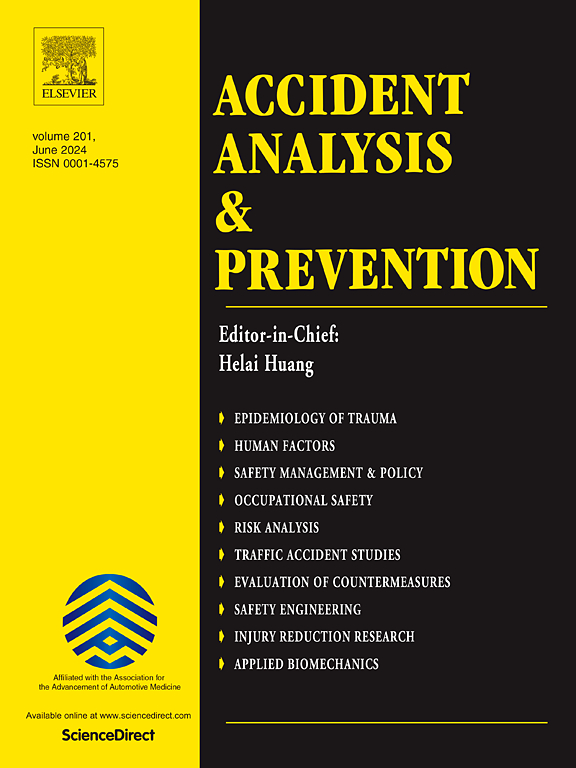Exploring the impact zone at spiral tunnel entrances and exits: Analyzing the vehicle control process from invalidation to recovery under environmental perturbations
IF 5.7
1区 工程技术
Q1 ERGONOMICS
引用次数: 0
Abstract
At tunnel entrances and exits, rapid transition in cross-sections and abrupt lighting changes create a brief “environmental perturbation period,” characterized by unstable vehicle dynamics until drivers regain control required by the new driving situation. During this period, the transition of vehicle control from invalidation to recovery is a critical zone for tunnel traffic safety. Different alignment radii may introduce unexpected perturbation to vehicle control in spiral tunnels with small-radius curves. This study adopts the Midicun Spiral Tunnel as a prototype, with three alignment design schemes for driving simulation experiments. A sliding window-based sample entropy method is applied to reveal the adaptation process of vehicle control from invalidation to recovery, and two indicators, model invalidation position (PMI) and model recovery position (PMR), are introduced for analyzing the spatial distribution characteristics of the perturbations. By considering both lateral steering and longitudinal speed control, the impact zone length of environmental perturbations at spiral tunnel entrances and exits is quantified using the 15 % and 85 % quartiles of PMI and PMR, respectively. Results reveal that vehicle control often invalidates before the tunnel entrance/exit and recovers within a certain distance afterward. While spiral tunnels do not significantly increase the overall impact zone compared to straight tunnels, the spatial distribution of these zones differs. At tunnel entrances, lateral steering control is the key to determining the impact zone length, which is longer than that influenced by speed control. Smaller alignment radii in spiral tunnels reduce steering impact zones before entrances but extend them after, with longer zones observed as the radius decreases. At the tunnel exit, steering control remains the key to determining the impact zone length. Before the exit, spiral tunnels exhibit larger steering impact zones than straight tunnels, especially with a 530 m radius. Conversely, straight tunnels show longer pre-exit impact zones due to earlier speed control invalidation. These findings, using straight tunnels as a reference, provide valuable insights into the safety management zones at spiral tunnel entrances and exits, offering theoretical support for optimizing alignment design and safety management. Furthermore, this study provides a methodological insight for investigating the impact of perturbations on the recovery mechanisms of vehicle control.
螺旋隧道出入口冲击区探索:环境扰动下车辆控制从失效到恢复过程分析
在隧道入口和出口,横断面的快速过渡和突然的照明变化造成了短暂的“环境扰动期”,其特征是车辆动力学不稳定,直到驾驶员重新获得新的驾驶情况所需的控制。在此期间,车辆控制从失效到恢复的过渡是影响隧道交通安全的关键环节。在小半径曲线的螺旋隧道中,不同的路线半径会给车辆控制带来意想不到的扰动。本研究以米村螺旋隧道为原型,采用三种线路设计方案进行行车仿真实验。采用基于滑动窗口的样本熵方法揭示了车辆控制从失效到恢复的自适应过程,并引入模型失效位置(PMI)和模型恢复位置(PMR)两个指标分析了扰动的空间分布特征。考虑横向转向和纵向速度控制,分别使用PMI和PMR的15%和85%四分位数量化螺旋隧道入口和出口环境扰动的影响区长度。结果表明,车辆控制往往在隧道出入口前失效,在出入口后一定距离内恢复。螺旋隧道总体冲击区与直线隧道相比没有显著增加,但空间分布有所不同。在隧道入口处,横向转向控制是决定冲击区长度的关键,而横向转向控制比速度控制影响的冲击区长度要长。在螺旋隧道中,较小的路线半径减少了入口前的转向影响区,但扩大了入口后的转向影响区,随着半径的减小,转向影响区变长。在隧道出口,转向控制仍然是确定冲击区长度的关键。在出口前,螺旋隧道比直线隧道表现出更大的转向冲击区,尤其是在半径为530 m时。相反,由于速度控制失效较早,直线隧道的出口前冲击区较长。以直线隧道为例,对螺旋隧道出入口安全管理区域的研究提供了有价值的见解,为优化线路设计和安全管理提供理论支持。此外,本研究为研究扰动对车辆控制恢复机制的影响提供了方法上的见解。
本文章由计算机程序翻译,如有差异,请以英文原文为准。
求助全文
约1分钟内获得全文
求助全文
来源期刊

Accident; analysis and prevention
Multiple-
CiteScore
11.90
自引率
16.90%
发文量
264
审稿时长
48 days
期刊介绍:
Accident Analysis & Prevention provides wide coverage of the general areas relating to accidental injury and damage, including the pre-injury and immediate post-injury phases. Published papers deal with medical, legal, economic, educational, behavioral, theoretical or empirical aspects of transportation accidents, as well as with accidents at other sites. Selected topics within the scope of the Journal may include: studies of human, environmental and vehicular factors influencing the occurrence, type and severity of accidents and injury; the design, implementation and evaluation of countermeasures; biomechanics of impact and human tolerance limits to injury; modelling and statistical analysis of accident data; policy, planning and decision-making in safety.
 求助内容:
求助内容: 应助结果提醒方式:
应助结果提醒方式:


